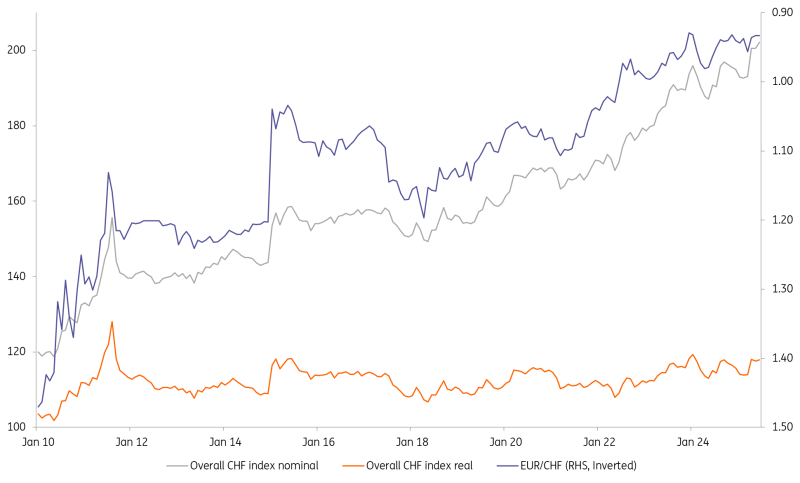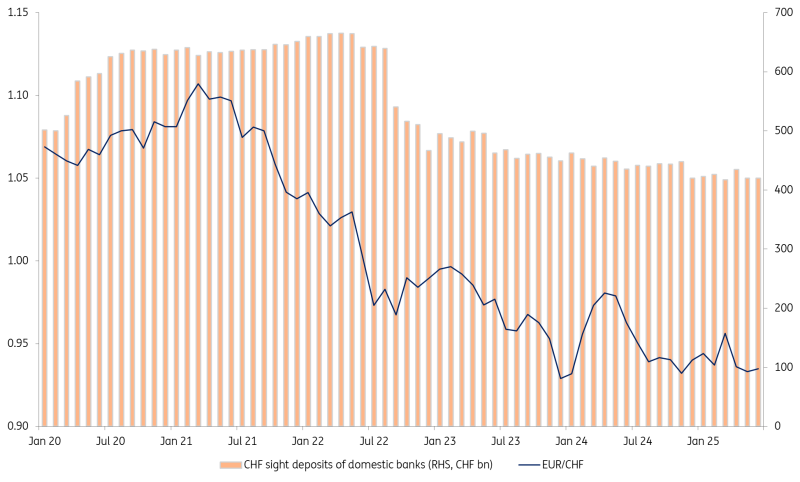Heading into Wednesday’s potential US tariff deadline, FX traders will remember that it was the that was the big winner at the height of April’s market unrest. Today, the Swiss franc remains very strong and the Swiss National Bank’s options to address its strength seem limited
Franc Close to Its Highs
Heading into Wednesday’s trade deadline the franc remains close to its highs against the and the . Traders will remember that the franc proved the stand-out winner when ’Liberation Day’ tariffs sank US asset markets in early April and no doubt many investors are now using the franc as a hedge should current benign conditions not last.
In terms of how strong the franc really is, the below chart shows a few measures: , the trade-weighted franc and also the ‘real’ franc which adjusts for inflation differentials. Back in the 2022 to 2023 period, the Swiss National Bank (SNB) focused heavily on the real CHF and at the time were concerned it could be too weak and inflationary. Hence the CHF160bn of FX sold by the SNB over that period to drive the franc stronger.
The tables are now very much turned from the 2022-2023 period. The real CHF is back at its highs, and the SNB is battling with inflation near zero. As Charlotte de Montpellier writes, import prices have a large weight in the Swiss inflation basket and the strong franc will be impactful.
For a central bank so keen to emphasise the importance of the exchange rate in Switzerland’s small and open economy, perhaps it’s been a surprise then that we’ve heard so few complaints from the SNB. One of the reasons that EUR/CHF is back at the lows is probably the lack of concern over franc strength in the June monetary policy decision. Comments such as ‘the Swiss franc is highly valued’ and ‘the SNB is prepared to intervene more strongly’ were conspicuous by their absence.
We suspect politics is playing a role here. Like many other major trading partners of the US, Switzerland is currently trying to negotiate a deal which will avoid tariffs reverting back to the 31% ‘Liberation Day’ levels and also do enough to protect its key pharmaceutical sector, which generates around half of Swiss exports. With discussions at a sensitive point, it remains difficult then for Switzerland to take any overt measures to weaken its currency – a topic at the heart of this year’s Mar-a-Lago narrative.
Let’s take a look at the SNB’s options.
Trade-Weighted Swiss Franc Strong in Both Nominal and Real Terms

Source: SNB, ING
Currency Intervention – Politically Challenging
Switzerland is already back on the US Treasury’s Monitoring List for currency manipulation. A concerted period of FX buying intervention now could see Switzerland formally named a currency manipulator and be exposed to increased tariffs. Since 2020, the SNB has been forced to report FX intervention activity more formally and releases quarterly data with a one-quarter lag.
Despite the political environment, most expect that the SNB will have to intervene again in EUR/CHF near the 0.9200/9250 area. We would expect the intervention to be in EUR/CHF rather than USD/CHF since its power to influence the far more liquid dollar market would be negligible.
Rate Cuts – Or Rate Tweaks
Charlotte thinks the will be forced to take rates negative again when it next meets for a policy decision in September. Some think that a hot property market could slow the SNB’s hand here, but if our eurozone team is right in their call that the European Central Bank (ECB) will be cutting to 1.75% in September, it looks like the SNB will have to act. Markets are currently pricing a 25% chance of an SNB rate cut – but are equally underpricing the risks of a 25bp ECB rate cut in September too.
One tweak – perhaps before September – that the SNB could make to rates is the following: it could increase the current 0.25% charge on CHF sight deposits held above the ‘threshold’. Currently, sight deposits earn the policy rate – now 0.00% – up to the threshold (18 times Minimum Reserves) and then are charged 25bp on deposits over that. That could easily be increased to a 0.50bp charge if pressure on the Swiss franc were to intensify.
That could be an interesting proposition, say, were the SNB to have bought a lot of FX and left the local banking system with much higher sight deposits, as it did during a large bout of intervention in 2020 – see chart below.
FX Intervention Would Lead to a Rise in CHF Sight Deposits

Source: SNB, ING
EUR/CHF – The Outlook
With the SNB struggling to keep pace with ECB rate cuts and the international investment environment remaining fragile, it looks like EUR/CHF can stay under pressure near 0.92/0.93 for the rest of the year. It could trade lower if the SNB’s hands are more tied than we think and FX intervention is more limited.
The outlook should improve in 2026, however. Fiscal stimulus should start to register in eurozone growth numbers from the start of next year and in the second half of 2026, investors could even be speculating over the first ECB rate hike. That could bring EUR/CHF back to 0.97/1.00 by late 2026.
ING’s EUR/CHF Forecast

Source: ING
Disclaimer: This publication has been prepared by ING solely for information purposes irrespective of a particular user’s means, financial situation or investment objectives. The information does not constitute investment recommendation, and nor is it investment, legal or tax advice or an offer or solicitation to purchase or sell any financial instrument. Read more
